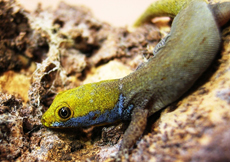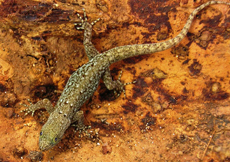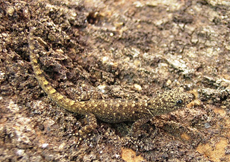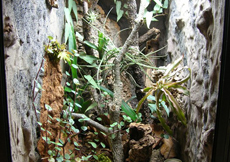Gonatodes albogularis albogularis
(DUMÉRIL & BIBRON, 1836)
Distribution:
Haiti (Aquin), Hispaniola, Jamaica, Grand Cayman, Martinique, Mexico, Guatemala, Honduras, Belize, Nicaragua, El Salvador, Costa Rica, Panama, North Colombia, Venezuela, Trinidad, Florida (introduced)
Description:
With a maximum overall length of 9 centimeters, Gonatodes albogularis albogularis remains slightly smaller than its well-known subspecies Gonatodes albogularis fuscus. As with all other species of Gonatodes, sexual dimorphism is strong. The upper half of the males head is yellow, while the lower half is bright blue, which then turns into a faded gray on the throat. The head is separated from the rest of the body color by a light blue ribbon around the neck. This body is colored light gray to pale blue. The tail has a yellowish tint, but lacks the white tip, which is a characteristic of the subspecies Gonatodes albogularis fuscus. The females are colored much more inconspicuous, with a brown base coloring, which is marbled with dark brown, gray and blue spots. Their neck features a slight collar like that on the males, however here it is colored gray and is a series of lines. Up until 8 months of age, young animals are colored the same as their mother, slowly after this point any males will begin to show their typical coloration.
Habitat:
Gonatodes albogularis albogularis inhabits both humid and semi-arid regions. The species is found on stone walls, and under dead wood or bark. The females bury their eggs either in dry areas or under loose bark.
Husbandry and Breeding:
Since Gonatodes albogularis albogularis is one of the smaller species of the genus Gonatodes, it is quite content in a terrarium measuring 30x40x30 centimeters. The rear and side walls, should be covered with natural cork, as to offer climbing surfaces. The substrate should be of a mixture of sand and soil, which should be kept slightly moist to achieve an overall humidity of 70-80% in the enclosure. The decor consists of suitable plants, cork bark and cork tubes as hiding places. Illumination is provided via T5 tubes rated for daylight color. Heat lamps are not required by Gonatodes albogularis albogularis, therefore the illumination should be the sole heat source. Daytime temperatures should range between 24-28°C (75-82°F) and at night the temperatures may drop safely by two to four degrees. In the winter months, the females should be allowed to rest before the next breeding season. During their rest, the daytime temperature should only reach a maximum of 24°C (75°F), while at night the temperature should be kept around 18°C (64°F).
In captivity Gonatodes albogularis albogularis is more visible than the more common subspecies Gonatodes albogularis fuscus. The animals are almost always visible, especially when food is being offered. Their diet should consist of small feeder insects such as crickets, cockroaches, firebrats and houseflies. In the warmer months field sweepings may also be added to their diet. Water should be made available at all times in the enclosure via a shallow dish and by misting daily. In order to provide the females with enough calcium, a shallow dish filled with crushed cuttlefish bone should be continuously available to them.
During the summer months, the females of Gonatodes albogularis albogularis lay at three weeks intervals a single egg in a dry location. For better management, the eggs should be placed in an incubator which is set between 26-28°C (79-82°F) time. The eggs hatch roughly around 100 days and the young emerge around 3.5 centimeters in length. The offspring can be raised in groups or individually in small terrariums. After about 9 months, any males will have their final coloration and are sexually mature in under a year. Females of this species should not be bred until they reach 14 months old, anything prior to this age could prove fatal!



